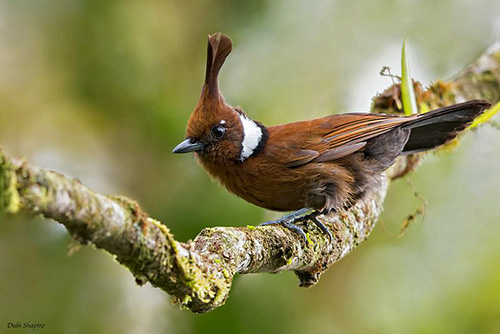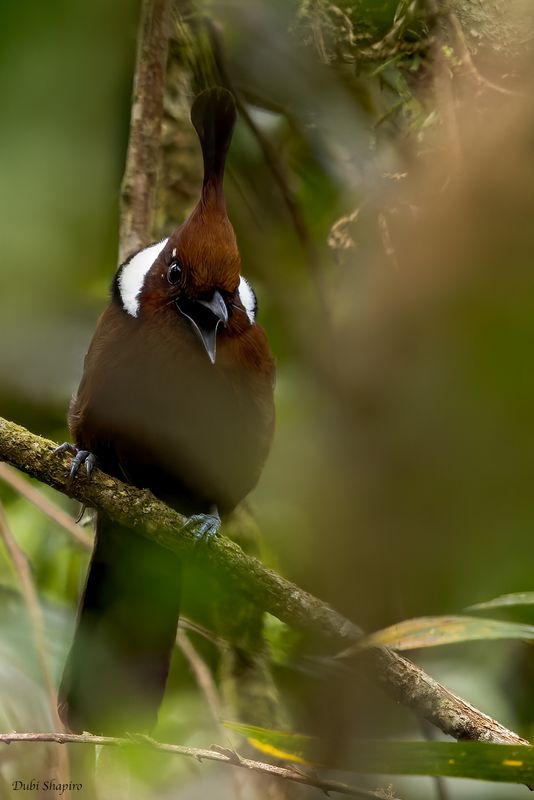
PROTECTION / THREATS / STATUS:
The Crested Shrikejay is threatened by habitat loss caused by heavy and rapid deforestation, illegal logging and land conversion, included inside protected areas. Forest fires also have a negative impact.
However, the Crested Shrikejay may move to hill and submontane forests, less threatened by logging for agriculture expansion.
But the species is also affected by illegal cagebird trade, especially the nominate race “galericulatus” from Java, probably due to the pale blue eyes. It has become very rare, and the race “coronatus” is now targeted to compensate the loss of “galericulatus” on the market.
The size of the population is unknown, but as the species may be tolerant to secondary habitats, the decline is slow and the species is considered locally common.
But currently, the Crested Shrikejay is listed as Near Threatened.
Fr: Geai longup - Platylophe longup
Ang: Crested Shrikejay - Crested Jay
All: Haubenhäher
Esp: Arrendajo Crestado
Ita: Ghiandaia crestata
Nd: Maleise Kuifgaai
Sd: tofsskrika
Photographers:
William Price
PBase-tereksandpiper & Flickr William Price
Dubi Shapiro
Dubi Shapiro Photo Galleries
Text by Nicole Bouglouan
Sources:
HANDBOOK OF THE BIRDS OF THE WORLD Vol 14 by Josep del Hoyo-Andrew Elliot-David Christie - Lynx Edicions – ISBN: 9788496553507
A Field Guide to the Birds of South-East Asia by Craig Robson. New Holland Publishers. ISBN: 9781780090498 – 544 pages
Birds of Borneo by G. W. H. Davison – Editeur: Bloomsbury Publishing, 2016 – ISBN: 1472932862, 9781472932860 – 144 pages
A Field Guide to the Birds of Peninsular Malaysia and Singapore by Allen Jeyarajasingam – Editeur: OUP Oxford, 2012 – ISBN: 0199639434, 9780199639434 – 449 pages
A family name for the Crested Shrikejay Platylophus galericulatus
Notes on the breeding of the Crested Jay Platylophus galericulatus
Malaysia Biodiversity Information System (MyBIS) - Native Animals
CREAGUS - CRESTED SHRIKEJAY Platylophidae
Picture Bird – Crested Jayshrike
Conservation breeding and the most threatened (song) birds in Asia—ten years on
Wikipedia, the free encyclopaedia
Home page
Page Passeriformes Order
Crested Shrikejay or Crested Jay
Platylophus galericulatus
Passeriformes Order – Platylophidae Family
INTRODUCTION:
The Crested Shrikejay is the only member of the genus Platylophus and the family Platylophidae. Little is known concerning its exact relationships or basic biology, despite being very similar to several jays in the family Corvidae.
This species is found in Sumatra, Borneo, Java and the Malay Peninsula where it frequents lowland and montane forests, from 750 to 1,800 metres of elevation depending on the range. Four subspecies are currently described.
The Crested Shrikejay feeds on a wide variety of invertebrates usually taken while foraging in the dense undergrowth or in the lower to middle forest canopy.
It is solitary breeder, building an open nest in thin branches of small tree. Both parents raise the chicks.
The Crested Shrikejay is threatened by habitat loss, forest fires and cagebird trade. Even not globally threatened, the species is currently listed as Near Threatened. The nominate race P.g. galericulatus is now considered “almost extinct” and remains very rare, and the race “P.g. coronatus” is now targeted to compensate this loss.

DESCRIPTION OF THE BIRD:
Biometrics:
Length: 31-33 cm
Weight: 78-114 g
The Crested Shrikejay of nominate race (not displayed) is virtually wholly blackish, except the long, white crescent on the side of the neck, and the two small white marks at the rear of the eye.
The upperwing may appear slightly paler, mostly blackish-brown on wing-coverts and flight-feathers. The graduated, medium-sized tail is slightly glossy.
On the head, we can see a conspicuous, very long, almost vertical crest formed by two elongated central feathers. The tips are broader than the rest of the crest feathers, and usually nod forwards.
The black bill is fairly small but with a hook at tip of upper mandible. The rictal bristles are long and conspicuous but it lacks obvious nasal tufts.
The eyes are pale blue. (Java species)
Legs and feet are black.
Male and female are similar.
The juvenile has tinged brown upperparts, whereas the underparts are duller and barred whitish. The wing-coverts are spotted warm buff. The crest is shorter than in adults and the feathers are tipped buffish.
Unlike the juveniles of family Corvidae, it lacks the unspotted plumage common in these young birds.
The immature resembles adult but the bars on the underparts are paler, while throat and breast show whitish shaft-streaks.
SUBSPECIES AND RANGE:
The Crested Shrikejay has four subspecies.
P.g. galericulatus (described above) is found in Java.
It is the only one with pale blue irises.
This race has been heavily persecuted by trappers, and had almost disappeared by the mid-2010s, both from the wild and from the bird markets. It was consequently being substituted by the form coronatus from Sumatra and Borneo.

P.g. ardesiacus
Very similar to nominate race
P.g. ardesiacus (displayed) is found in the Malay Peninsula. It is sometimes treated as synonym of nominate.
This one is slightly duller and paler than nominate. The conspicuous white crescent on the side of the neck extends upwards to the nape while becoming broader. On the rear eye, the upper white mark is larger. The eyes are reddish-brown.
P.g. coronatus (displayed) occurs in Sumatra and Borneo, except N.
This race has rich tawny-rufous plumage overall but on the underparts, lower belly, vent and undertail are slightly paler, mostly brownish-grey. On the neck side, the white crescent is bordered in black, especially below on the lower neck.
On the rear of the eye, only one white mark is visible at top of the eye. The eyes are reddish-brown.
The central crest feathers are darker and browner towards the tip than rest of head and overall plumage.

P.g. lemprieri is found in N Borneo.
This one resembles “coronatus” but the plumage is paler overall. The eyes are reddish-brown.
HABITAT:
The Crested Shrikejay frequents both lowland and montane forests. It is rarely seen at the edge or in open. It forages and feed inside the foliage in the bushy undergrowth or in lower to middle tree canopy.
These forests present a rich diversity of large deciduous trees, well adapted to the feeding, reproductive and survival behaviour usual for this species.
The Crested Shrikejay can be seen around 750 metres of elevation in Thailand, up to 1,000 metres in Sumatra, and 1,800 metres in Borneo.
CALLS AND SONGS: SOUNDS BY XENO-CANTO
The Crested Shrikejay’s usual call is a very rapid, grating metallic rattle “tit’it’it’it’it’it’it’it’it…”
The alarm call is distinctive and described as a “machine-gun-like” loud, harsh, rapid chatter “tat-tat-tat-tat-tat-tat…”
The song is a special fluty phrase preceded by an abrupt, high-pitched whistle “psSSSsiu HI-WU” usually repeated every few seconds and constantly while the birds are moving through the foraging territory.

BEHAVIOUR IN THE WILD:
The Crested Shrikejay is a bird difficult to find while foraging inside the foliage and the brushy undergrowth, or in lower to middle tree canopy. It forages alone or in small parties, and group cohesion depends on the white markings of both eyes and neck.
The diet of this species is not completely known, but invertebrates such as large hairy caterpillars, millipedes, cicadas, beetles, grasshoppers, crickets, wasps and cockroaches are the main part of its diet.
The Crested Shrikejay is known for its boldness when it approaches humans. The birds can be seen bobbing and weaving, raising and lowering the crest while uttering shrieking calls.
The small parties or family groups encountered by humans are often fast-moving and restless, although remaining hard to see.

The behaviour of this species during the breeding season is poorly known. We can suggest that the social displays previously described resemble some courtship displays, but more information is needed. Both crest and white markings probably play a role during the displays.
The Crested Shrikejay builds an open nest made with twigs, fairly similar to pigeon’s nest, usually in small tree. Both adults care for the young.
The species is described as resident, but being possibly nomadic to a certain extent.
The Crested Shrikejay is observed constantly on the move, flying from branch to branch and occasionally raising its long crest.

REPRODUCTION OF THIS SPECIES:
The breeding season takes place in June/July and October/February in Java. In Malay Peninsula, the laying occurs in February.
From an observation on 15 June 1995 in Central java, some interesting facts have been described.
A nest was found two metres above the ground, in a thinly branched 4-5 metres tall tree. This tree was on a rather steep slope at 950 metres of elevation, and about 100 metres from a small river. Numerous large trees were in the surrounding habitat. The Crested Shrikejays were common in this area, calling when the nest was discovered.
The nest, an open cup very similar to a pigeon’s nest, was built on a thin branch, less than a metre from the main stem. The lower layer was made of twigs, some of them larger than those of the cup itself placed just above. It was well lined with fine, brown, curly strips of fern fronds.
A single, whitish egg with scattered red-brown spots was in the nest. It was identified as an egg of Crested Shrikejay.
Incubation and nesting periods are not documented. Both parents take part in nesting duties.
No more information.
